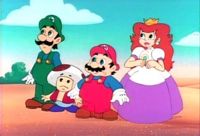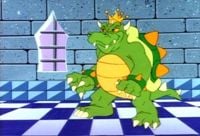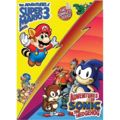The Adventures of Super Mario Bros. 3: Difference between revisions
(→US) |
|||
| Line 117: | Line 117: | ||
* The Mushroom Kingdom and Grass Land were considered one and the same, despite the fact that in the game, Grass Land is a separate land from the Mushroom Kingdom, and is ruled by its own [[Mushroom King|king]]. This was likely done due to the fact that the Mushroom Kingdom didn't actually appear in the game, and because the two lands were fairly similar. | * The Mushroom Kingdom and Grass Land were considered one and the same, despite the fact that in the game, Grass Land is a separate land from the Mushroom Kingdom, and is ruled by its own [[Mushroom King|king]]. This was likely done due to the fact that the Mushroom Kingdom didn't actually appear in the game, and because the two lands were fairly similar. | ||
* Aside from the enemies that appeared in the show and not included were [[Spike]], [[Buster Beetle]], [[Muncher]], [[Roto-Disc]], [[Stretch]], and [[Spiny Cheep-Cheep]]. | * Aside from the enemies that appeared in the show and not included were [[Spike]], [[Buster Beetle]], [[Muncher]], [[Roto-Disc]], [[Stretch]], and [[Spiny Cheep-Cheep]]. | ||
* Princess Peach/Toadstool recieved a graphical makeover for the cartoon, and it makes her look a little more 'pretty princess-like' | |||
== Gallery == | == Gallery == | ||
Revision as of 23:42, October 9, 2008
The Adventures of Super Mario Bros. 3 was the second Mario television cartoon produced by DiC Entertainment, and was based off of Super Mario Bros. 3. An apparent continuation of The Super Mario Bros. Super Show!, this series served as a bit of a turning point for the DiC version of Mario.
Unlike The Super Mario Bros. Super Show!, which was broadcasted five days a week in syndication, The Adventures of Super Mario Bros. 3 was aired on Saturday mornings on NBC, alongside Captain N: The Game Master for the 1990-1991 season. The two shows originally aired in a one-hour package entitled Captain N & The Adventures of Super Mario Bros. 3, which consisted of a half-hour episode of Captain N: The Game Master sandwiched between two fifteen-minute Mario episodes. The two shows were then split up for later airings.
While The Super Mario Bros. Super Show! mainly dealt with Mario and Luigi helping Princess Peach Toadstool and Toad trying to stop King Bowser Koopa from taking over the Mushroom Kingdom and other lands, The Adventures of Super Mario Bros. 3 took place some time later, after the events of the game, when the Mushroom Kingdom was in a more peaceful state.
As it was based off of Super Mario Bros. 3, the feel of the Mushroom Kingdom changed to better resemble the game. The various worlds of Super Mario Bros. 3 were visited regularly, and new Power-Ups such as Super Leaves and Frog Suits appeared. King Koopa also changed his army, losing Wart's minions, but gaining more of his own, including Boom Booms, Boomerang Bros., Sledge Bros., Dry Bones, and many more. Although characters continued to call him King Koopa like they did on The Super Mario Bros. Super Show!, his full name, Bowser Koopa, was mentioned in a few episodes.
One notable addition to the cast was Bowser's seven Koopalings, who were given alternate names for the show. Although DiC has never properly explained why different names were issued for the Koopalings, they hadn't been named by Nintendo of America when the show began production. Because they needed names for the characters, the writers would have had to make up names of their own.
Other features of the show included Toad's House and the Mushroom Castle, where the protagonists often resided between their adventures. The Koopa family took up residence at Kastle Koopa, located in the heart of Dark Land. In many episodes, the Koopas would use their Doomship to launch their attacks.
The series has recently been released on DVD by Shout! Factory and MRA Entertainment, as well as the Super Mario World cartoon series.
Broadcast History
US
- NBC
- The Family Channel
- PAX Network
UK
- Channel 4 (?-1999)
- The Children's Channel
- Disney Channel UK
- POP! (2004–)
- ITV2
Opening Narration
It is a legend no one will forget.
Everyone thought King Koopa had left the Mushroom Kingdom.
And then... his Doomship attacked!
King Koopa was back!
With the greatest danger ever known...
His Koopa Kids!
Using their new super powers,
The Super Mario Bros. rescued Princess Toadstool,
And beat back the evil Koopa family.
Bowser: I'LL GET THOSE PLUMBERS!
Cast
- Walker Boone — Mario
- Tony Rosato — Luigi
- Tracey Moore — Princess Toadstool
- John Stocker — Toad
- Harvey Atkin — King Koopa
- Tara Strong — Hip and Hop
- Paulina Gillis — Kootie Pie
- James Rankin — Cheatsy
- Gordon Masten — Bully
- Michael Stark — Kooky
- Dan Hennessey — Big Mouth
- Stuart Stone — (Additonal Voices)
- Bonnie Brooks — (Additonal Voices)
- Rod Coneybeare — (Additonal Voices)
- Diane Fabian — (Additonal Voices)
- Catherine Gallant — (Additonal Voices)
- Greg Morton — (Additonal Voices)
- Jonathan Potts — (Additonal Voices)
- Susan Roman — (Additonal Voices)
- Linda Sorenson — (Additonal Voices)
- Marlow Vella — (Additonal Voices)
Episodes
- Sneaky Lying Cheating Giant Ninja Koopas
- Reptiles in the Rose Garden
- Mind Your Mummy Mommy, Mario
- The Beauty of Kootie
- Princess Toadstool for President
- Never Koop a Koopa
- Reign Storm
- Toddler Terrors of Time Travel
- Dadzilla
- Tag Team Trouble
- Oh, Brother!
- Misadventure of Mighty Plumber
- A Toadally Magical Adventure
- Misadventures in Babysitting
- Do the Koopa
- Kootie Pie Rocks
- Mush-Rumors
- The Ugly Mermaid
- Crimes R Us
- Life's Ruff
- Up, Up, and a Koopa
- 7 Continents for 7 Koopas
- True Colors
- Recycled Koopa
- The Venice Menace
- Super Koopa
Artistic licences
- The Koopalings were given different names for the show than the ones they had for the game. Also, some of their cartoon designs deviated from their game artwork a fair bit. In the French dub of the show, King Koopa was regularly referred to as Bowser, and the Koopalings went by their game names. Also a few episodes had King Koopa called by his full name "Bowser Koopa", which is his actual game name.
- Although Nintendo had swapped the colors of Mario and Luigi's shirts and overalls by the time SMB3 was released, DiC never did so for in the show. However, the artwork for Shout! Factory DVD set of the show portrays Mario with his updated color swap.
- There was only one single Airship, which was referred to as the "Doomship".
- Standard Super Leaves granted near-limitless flight power, as if they were P-Wings.
- Kuribo's Shoe was referred to as "Karoobi's Shoe".
- The Mushroom Kingdom and Grass Land were considered one and the same, despite the fact that in the game, Grass Land is a separate land from the Mushroom Kingdom, and is ruled by its own king. This was likely done due to the fact that the Mushroom Kingdom didn't actually appear in the game, and because the two lands were fairly similar.
- Aside from the enemies that appeared in the show and not included were Spike, Buster Beetle, Muncher, Roto-Disc, Stretch, and Spiny Cheep-Cheep.
- Princess Peach/Toadstool recieved a graphical makeover for the cartoon, and it makes her look a little more 'pretty princess-like'










